Minigun
The M134 Minigun is a 7.62×51mm NATO six-barrel rotary machine gun with a high, sustained rate of fire (2,000 to 6,000 rounds per minute).[2] It features a Gatling-style rotating barrel assembly with an external power source, normally an electric motor. The "Mini" in the name is in comparison to larger-caliber designs that use a rotary barrel design, such as General Electric's earlier 20 mm M61 Vulcan, and "gun" for the use of rifle ammunition as opposed to autocannon shells.
| Machine Gun, High Rate, Caliber 7.62-mm, M134 | |
|---|---|
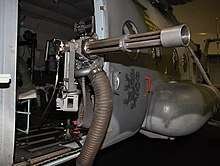 A Dillon Aero M134D minigun in 2017 | |
| Type | Rotary heavy machine gun |
| Place of origin | United States |
| Service history | |
| In service | 1963–present |
| Used by | See Users below |
| Wars | |
| Production history | |
| Designer | General Electric |
| Designed | 1960 |
| Manufacturer |
|
| Produced | 1962–present |
| Variants | See Design and variants below |
| Specifications | |
| Mass | 85 lb (39 kg), 41 lb (19 kg) lightweight mod. |
| Length | 801.6 mm (31.56 in) |
| Barrel length | 558.8 mm (22.00 in) |
| Cartridge | 7.62×51mm NATO |
| Caliber | 7.62 mm (0.308 in) |
| Barrels | 6 |
| Action | Electrically driven rotary breech |
| Rate of fire | Variable, 2,000–6,000 rpm |
| Muzzle velocity | 2,800 ft/s (850 m/s) |
| Maximum firing range | 3,280 ft (1,000 m; 1,090 yd) |
| Feed system | Disintegrating M13 linked belt or linkless feed; dependent on installation [500-5,000-round belt] |
| Sights | Dependent on installation; no fixed sights |
"Minigun" refers to a specific model of weapon that General Electric originally produced, but the term "minigun" has popularly come to refer to any externally powered rotary gun of rifle caliber. The term is sometimes used loosely to refer to guns of similar rates of fire and configuration, regardless of power source and caliber.
The Minigun is used by several branches of the U.S. military. Versions are designated M134 and XM196 by the United States Army, and GAU-2/A and GAU-17/A by the U.S. Air Force and U.S. Navy.
History
Background: electrically driven Gatling gun
The ancestor to the modern minigun was a hand cranked mechanical device invented in the 1860s by Richard Jordan Gatling. Gatling later replaced the hand-cranked mechanism of a rifle-caliber Gatling gun with an electric motor, a relatively new invention at the time. Even after Gatling slowed the mechanism, the new electric-powered Gatling gun had a theoretical rate of fire of 3,000 rounds per minute, roughly three times the rate of a typical modern, single-barreled machine gun. Gatling's electric-powered design received U.S. Patent #502,185 on July 25, 1893.[3] Despite Gatling's improvements, the Gatling gun fell into disuse after cheaper, lighter-weight, recoil and gas operated machine guns were invented; Gatling himself went bankrupt for a period.[4]
During World War I, several German companies were working on externally powered guns for use in aircraft. Of those, the best-known today is perhaps the Fokker-Leimberger, an externally powered 12-barrel rotary gun using the 7.92×57mm Mauser round; it was claimed to be capable of firing over 7,000 rpm, but suffered from frequent cartridge-case ruptures[5] due to its "nutcracker", rotary split-breech design, which is fairly different from that of conventional rotary gun designs.[6] None of these German guns went into production during the war, although a competing Siemens prototype (possibly using a different action), which was tried on the Western Front, scored a victory in aerial combat.[5] The British also experimented with this type of split-breech during the 1950s, but they were also unsuccessful.[7]
Minigun: 1960s–Vietnam
In the 1960s, the United States Armed Forces began exploring modern variants of the electric-powered, rotating barrel Gatling-style weapons for use in the Vietnam War. American forces in the Vietnam War, which used helicopters as one of the primary means of transporting soldiers and equipment through the dense jungle, found that the thin-skinned helicopters were very vulnerable to small arms fire and rocket-propelled grenade (RPG) attacks when they slowed to land. Although helicopters had mounted single-barrel machine guns, using them to repel attackers hidden in the dense jungle foliage often led to overheated barrels or cartridge jams.[8][9]
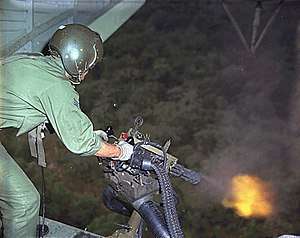
To develop a more reliable weapon with a higher rate of fire, General Electric designers scaled down the rotary-barrel 20 mm M61 Vulcan cannon for 7.62×51mm NATO ammunition. The resulting weapon, designated M134 and known as the "Minigun", could fire up to 6,000 rounds per minute without overheating. The gun has a variable (i.e. selectable) rate of fire, specified to fire at rates of up to 6,000 rpm with most applications set at rates between 3,000–4,000 rounds per minute.
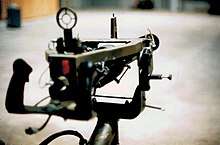
The Minigun was mounted on Hughes OH-6 Cayuse and Bell OH-58 Kiowa side pods; in the turret and on pylon pods of Bell AH-1 Cobra attack helicopters; and on door, pylon and pod mounts on Bell UH-1 Iroquois transport helicopters. Several larger aircraft were outfitted with miniguns specifically for close air support: the Cessna A-37 Dragonfly with an internal gun and with pods on wing hardpoints; and the Douglas A-1 Skyraider, also with pods on wing hardpoints. Other famous gunship airplanes are the Douglas AC-47 Spooky, the Fairchild AC-119, and the Lockheed AC-130.[9]
Dillon Aero minigun
The U.S. government had procured some 10,000 Miniguns during the Vietnam War.[10] Around 1990, Dillon Aero acquired a large number of Miniguns and spares from "a foreign user". The guns kept failing to shoot continuously, revealing that they were actually worn-out weapons. The company decided to fix the problems encountered, rather than simply putting the guns into storage. Fixing failure problems ended up improving the Minigun's overall design. Dillon's efforts to improve the Minigun reached the 160th SOAR, and the company was invited to Fort Campbell, Kentucky to demonstrate its products. A delinker, used to separate cartridges from ammunition belts and feed them into the gun housing, and other parts were tested on Campbell's ranges. The 160th SOAR were impressed by the delinker's performance and began ordering them by 1997. This prompted Dillon to improve other design aspects including the bolt, housing and barrel. Between 1997 and 2001, Dillon Aero was producing 25–30 products a year. In 2001, it was working on a new bolt design that increased performance and service life. By 2002, virtually every component of the minigun had been improved, so Dillon began producing complete weapons with improved components. The guns were purchased quickly by the 160th SOAR as its standardized weapon system. The gun then went through the Army's formal procurement system approval process and in 2003 the Dillon Aero minigun was certified and designated M134D.[10] Once the Dillon Aero system was approved for general military service, Dillon Aero GAU-17s entered Marine Corps service and were well received in replacing the GE GAU-17s serving on Marine UH-1s.[11]
The core of the M134D was a steel housing and rotor. To focus on weight reduction, a titanium housing and rotor were introduced, creating the M134D-T which had reduced weight from 62 lb (28 kg) to 41 lb (19 kg). The gun housing had a 500,000 round lifespan before it wore out, which was far higher than a conventional machine gun's 40,000-round lifespan but lower than that of other rotary guns. A hybrid of the two weapons resulted in the M134D-H, which had a steel housing and titanium rotor. It was cheaper with the steel component and only 1 lb (0.45 kg) heavier than the M134D-T, and restored its lifespan to 1.5 million rounds.[10][12] The M134D-H is currently in use on various 160th Regiment platforms.[10]
Dillon also created specialized mounts and ammunition-handling systems. Initially, mounts were made only for aviation systems. Then from 2003 to 2005, the Navy began mounting Dillon miniguns on specialized small boats. In 2005, the Naval Surface Warfare Center Crane Division procured guns to mount on Humvees. In Iraq, US Army Special Forces units on the ground were frequently engaged by opposition forces, so they mounted M134D miniguns on their vehicles for additional firepower. After several engagements the attackers seemed to avoid vehicles with miniguns. Later, the Special Forces units began concealing their weapons so opposition troops would not know they were facing the weapon; the regular Army units did the opposite, creating minigun mock-ups out of painted PVC pipes tied together to resemble barrels to intimidate enemies.[10]
Garwood Industries minigun
Garwood Industries created the M134G version with several modifications to the original GE system. The optimum rate of fire was determined by Garwood to be around 3,200 rounds per minute (rpm). The M134G is being produced with this firing rate as well as 4,000 rpm and the previous standard 3,000 rpm rate.[13]
Garwood Industries made several other modifications to the 1960s Minigun design in order to meet modern day military and ISO standards.[13] This includes modifications to the drive motor, feeder and barrel clutch assembly.[14]
From 2015 to 2017 Garwood Industries CEO Tracy Garwood collaborated with firearms dealer Michael Fox and weapons smuggler Tyler Carlson to supply miniguns to Mexican drug cartels. Garwood submitted false paperwork to the ATF claiming that a number of M-134G rotor housings had been destroyed when in fact they were sold to the gun running ring. In 2017 federal agents raided Fox's home and recovered two of the rotor housings that Garwood had reported destroyed. A number of the rotor housings were successfully shipped to Mexico and a completed M-134G using a rotor housing reported destroyed was recovered from a cartel by Mexican law enforcement.[15] Garwood did not know that the intended buyers were Mexican cartels although he was aware that they were to be used for illegal activity.[16]
Design and variants

The basic minigun is a six-barrel, air-cooled, and electrically driven rotary machine gun. The electric drive rotates the weapon within its housing, with a rotating firing pin assembly and rotary chamber.[17] The minigun's multi-barrel design helps prevent overheating, but also serves other functions. Multiple barrels allow for a greater capacity for a high firing rate, since the serial process of firing, extraction, and loading is taking place in all barrels simultaneously. Thus, as one barrel fires, two others are in different stages of shell extraction and another three are being loaded. The minigun is composed of multiple closed-bolt rifle barrels arranged in a circular housing. The barrels are rotated by an external power source, usually electric, pneumatic, or hydraulic. Other rotating-barrel cannons are powered by the gas pressure or recoil energy of fired cartridges. A gas-operated variant, designated XM133, was also developed.[18]
While the weapon can feed from linked ammunition, it requires a delinking feeder to strip the links as the rounds are fed into the chambers. The original feeder unit was designated MAU-56/A, but has since been replaced by an improved MAU-201/A unit.[19]
%2C_Special_Boat_Team_22_conducts_training_16_AUG_09.jpg)
The General Electric minigun is used in several branches of the U.S. military, under a number of designations. The basic fixed armament version was given the designation M134 by the United States Army, while the same weapon was designated GAU-2/A (on a fixed mount) and GAU-17/A (flexible mount) by the United States Air Force (USAF) and United States Navy (USN). The USAF minigun variant has three versions, while the US Army weapon appears to have incorporated several improvements without a change in designation. The M134D is an improved version of the M134 designed and manufactured by Dillon Aero,[20] while Garwood Industries manufactures the M134G variant.[21] Available sources show a relation between both M134 and GAU-2/A and M134 and GAU-2B/A.[22][23] A separate variant, designated XM196, with an added ejection sprocket was developed specifically for the XM53 Armament Subsystem on the Lockheed AH-56 Cheyenne helicopter.[24]
Another variant was developed by the USAF specifically for flexible installations, beginning primarily with the Bell UH-1N Twin Huey helicopter, as the GAU-17/A. Produced by General Dynamics, this version has a slotted flash hider. The primary end users of the GAU-17/A have been the USN and the United States Marine Corps (USMC), which mount the gun as defensive armament on a number of helicopters and surface ships. GAU-17/As from helicopters were rushed into service for ships on pintle mountings taken from Mk16 20 mm guns for anti-swarm protection in the Gulf ahead of the 2003 Iraq War - 59 systems were installed in 30 days.[25] The GAU-17/A is designated Mk 44 in the machine gun series[25] and is generally known as the Mk 44 when installed on British warships.
The weapon is part of both the A/A49E-11 armament system on the UH-1N; and of the A/A49E-13 armament subsystem on the USAF Sikorsky HH-60H Pave Hawk helicopter. The weapons on these systems feature a selectable fire rate of either 2,000 or 4,000 rpm. There is mention of a possible GAUSE-17 designation (GAU-Shipboard Equipment-17), in reference to the system when mounted on surface ships, though this would not follow the official ASETDS designation system's format.[26][27]
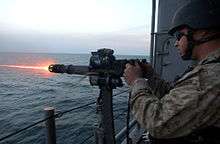
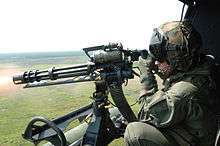
| US Army designation | US Air Force designation | US Navy designation | Description |
|---|---|---|---|
| XM134/M134 | GAU-2/A | N/A | 7.62×51mm NATO GE "Minigun" 6-barreled machine gun |
| N/A | GAU-2A/A | N/A | GAU-2/A variant; unknown differences |
| M134 | GAU-2B/A | Mk 25 Mod 0 | GAU-2A/A variant; unknown differences |
| N/A | GAU-17/A | N/A | GAU-2B/A variant; optimized for flexible use, uses either an MAU-201/A or MAU-56/A delinking feeder. |
| XM214 Microgun | N/A | N/A | Scaled-down variant of the XM134 firing the 5.56×45mm NATO round. |
| XM196 | N/A | N/A | M134/GAU-2B/A variant; housing modified by addition of an ejection sprocket; for use in the XM53 armament subsystem on the AH-56 helicopter |
Gun pods and other aircraft mounts
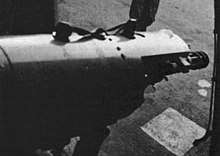
One of the first applications of the weapon was in aircraft armament pods. These gun pods were used by a wide variety of fixed and rotary wing aircraft mainly during the Vietnam War, remaining in inventory for a period afterward. The standard pod, designated SUU-11/A by the Air Force and M18 by the U.S. Army, was a relatively simple unit, completely self-contained, with a 1,500-round magazine directly feeding delinked ammunition into the weapon. This means the Minigun fitted to the pod does not require the standard MAU-56/A delinking feeder unit.[28] A number of variations of this pod exist.
Initially on fixed-wing gunships such as the Douglas AC-47 Spooky and Fairchild AC-119, the side-firing armament was fitted by combining SUU-11/A aircraft pods, often with their aerodynamic front fairings removed, with a locally fabricated mount. These pods were essentially unmodified, required no external power, and were linked to the aircraft's fire controls. The need for those pods for other missions led to the development and fielding of a purpose built "Minigun module" for gunship use, designated the MXU-470/A. These units first arrived in January 1967 with features such as an improved 2,000-round drum and electric feeder allowing simplified reloading in flight. The initial units were unreliable and were withdrawn almost immediately.[29] By the end of the year, however, the difficulties had been worked out and the units were again being fitted to AC-47s, AC-119s, AC-130s, and even being proposed for lighter aircraft such as the Cessna O-2 Skymaster.[30] A fit of two MXU-470/As was also tested on the Fairchild AU-23A Peacemaker, though the Royal Thai Air Force later elected to use another configuration with the M197 20 mm cannon.[31]
In September 2013, Dillon Aero released the DGP2300 gun pod for the M134D-H. It contains 3,000 rounds, enough ammunition to fire the minigun for a full minute. The system is entirely self-contained. So it can be mounted on any aircraft that can handle the weight, rotational torque, and recoil force (190 lbf (850 N)) of the gun. The pod has its own battery which can be wired into the aircraft's electrical system to maintain a charge.[32]
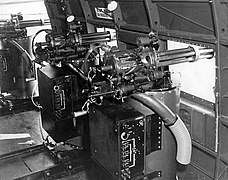
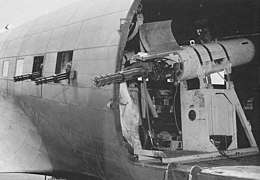
| US Army designation | US Air Force designation | Description |
|---|---|---|
| XM18 | SUU-11/A | Gun pod fitted with the GAU-2/A/M134 7.62 mm machine gun and fixed rate of fire of 4,000 RPM[33] |
| XM18E1/M18 | SUU-11A/A | SUU-11/A/XM18 variant; various improvements including additional auxiliary power and selectable fire-rate capability (2,000 or 4,000 RPM)[34] |
| M18E1/A1 | SUU-11B/A | SUU-11A/A/M18 variant; differences modified selectable fire-rate capability (3,000 or 6,000 RPM)[22] |
| N/A | MXU-470/A | Emerson Electric module for mounting a GAU-2B/A minigun; used in AC-47, AC-119G/K, and AC-130A/E/H aircraft |
Various iterations of the minigun have also been used in a number of armament subsystems for helicopters, with most of these subsystems being created by the United States. The first systems utilized the weapon in a forward firing role for a variety of helicopters, some of the most prominent examples being the M21 armament subsystem for the UH-1 and the M27 for the OH-6. It also formed the primary turret-mounted armament for a number of members of the Bell AH-1 Cobra family. The weapon was also used as a pintle-mounted door gun on a wide variety of transport helicopters, a role it continues to fulfill today.
| US Navy designation | Description |
|---|---|
| Mk 77 Mod 0 | Machine gun mount for the GAU-2/Mk 25 Mod 0/GAU-17 series of machine guns; deck mount applications |
Users


.svg.png)


.svg.png)




































Fiction and popular culture
A distinctive invention of fiction is the hand-held M134 minigun (often with a chainsaw-style grip), a concept which was popularized by the 1980s–90s films Predator and Terminator 2: Judgment Day, wielded by Jesse Ventura/Bill Duke and Arnold Schwarzenegger respectively, and decades later still appears in video games and films such as Captain America: The Winter Soldier, the Grand Theft Auto series, Team Fortress 2, and Furious 7 (fired by Dwayne Johnson).[42][43][9] The chainsaw-style grip layout has also been carried over to single-barrel machine guns.
Generally, such depictions totally ignore the weapon's need for external power, and sometimes even neglect the need for ammunition. For movie use, armorers slow down the M134 minigun's rate of fire to conserve ammo, and to allow the spinning barrels to be visible to the movie audience, with a hidden power cable for the firing scenes, and using blank ammo to ease recoil. Nonetheless, the prop is still extremely physically demanding, hence the actors wielding it are physically imposing and often have bodybuilding backgrounds. In practice, a man-portable M134 minigun would be nearly impossible to manage as an individual infantry weapon, and highly impractical for a human being to either carry or operate. A scaled-down version of the M134, the XM214 Microgun, firing 5.56×45mm M193 ammunition, prototype was developed as a man-portable weapon system. However, the U.S. military lost interest and it never reached mass production status.[42][44]
See also
- Multiple-barrel firearm – Class of firearm with more than one barrel
- List of multiple barrel firearms
- GAU-19 – An electrically-driven heavy machine gun
- Glagolev-Shipunov-Gryazev GShG-7.62
- Komodo Armament Eli gun – Indonesian six-barrel rotary machine gun
- EX-17 Heligun – A two-barrel 7.62 mm calibre machine gun
- Hua Qing Minigun – A Chinese Gatling-type machine gun
References
Notes
- "M134 Minigun fun in Afghanistan". 30 March 2014. Archived from the original on 4 November 2015. Retrieved 28 May 2017 – via YouTube.
- "Dillon Aero M134D Minigun Weapon System" (Press Video). Shooting Resources.
- "U.S. Patent 502185 Gatling Gun". Retrieved February 4, 2010.
- Chivers, C. J. (2010). The Gun. Simon & Schuster. pp. 116–119. ISBN 978-1-4391-9653-3.
- Weyl, A. R. (8 March 1957). "Motor-guns—a Flashback to 1914-18". Flight. 71 (2511): 313–314. Archived from the original on 2 October 2015. Retrieved 30 September 2015.
- Williams, Anthony G. (8 November 2005). "Split Breech Guns: The Nutcracker and the 40mm Mk 18". Archived from the original on 14 June 2007.
- Williams, Anthony G.; Gustin, Emmanuel (2005). Flying Guns of the Modern Era. Crowood. p. 55. ISBN 978-1-86126-655-2.
- "General Electric M134 Minigun Six-Barrel Gatling Gun". Archived from the original on 2017-06-08. Retrieved 2017-07-10.
- Jarvis, John Paul. "Brought to You By GE: The M134 Minigun". Archived from the original on 2012-02-19. Retrieved 2017-09-01.
- Gourley, Scott W. (30 May 2013). "The Evolution of the M134D Minigun". Defense Media Network. Archived from the original on 6 February 2015. Retrieved 5 February 2015.
- Experience of Marine Corps Light Attack H-1 Squadrons
- "Hybrid M134D-H: M134 Gun Systems". Dillon Aero. Archived from the original on 1 October 2015. Retrieved 30 September 2015.
- "Garwood Industries M134G Minigun". The Bang Switch. 7 June 2013. Archived from the original on 1 October 2015. Retrieved 30 September 2015.
- "M134G Gun Control Unit". Garwood Industries. Archived from the original on 24 September 2015. Retrieved 30 September 2015.
- Harp, Seth. "Arming the Cartels: The Inside Story of a Texas Gun-Smuggling Ring". Rolling Stone. Retrieved 19 October 2019.
- "Austin Man Sentenced to Federal Prison for Firearms Smuggling Scheme". www.justice.gov. United States Department of justice. Retrieved 19 October 2019.
- United States, 1969. p. D-37-8
- United States, 1969. p. B-2.
- United States, 1969. p. C-31.
- "Standard M134D". Dillon Aero. 2015. Archived from the original on 29 September 2015. Retrieved 30 September 2015.
- "Garwood Industries M134G Minigun". Garwood Industries. 2013. Archived from the original on 7 November 2015. Retrieved 30 September 2015.
- Jane's, 1986. pp. 453–4
- Gunston, 1988. pp. 188–9.
- "U.S. Army Helicopter Weapons". U.S. Army TACOM-RI. 24 February 2006. Archived from the original on 4 February 2008. Retrieved 8 January 2008.
- Friedman, Norman (2006). The Naval Institute Guide to World Naval Weapon Systems. Naval Institute Press. p. 491. ISBN 9781557502629.
- DiGiulian, Tony (30 October 2006). "USA 0.30 caliber (7.62 mm) Minigun". NavWeaps.com. Archived from the original on 26 February 2008. Retrieved 3 April 2008.
- Parsch, Andreas (23 June 2006). "Designations Of U.S. Aeronautical and Support Equipment". Designation-Systems.net. Archived from the original on 3 March 2008. Retrieved 3 April 2008.
- United States, 1969, p. G-1-3
- Ballad, 1982. p. 57
- Ballad, 1982. pp. 77, 251
- Davis, 1982, p. 62
- "You Call That High Capacity?". Thefirearmblog.com. 11 September 2013. Archived from the original on 30 September 2013. Retrieved 14 September 2013.
- United States, 1969. p. G-1
- United States, 1969. p. G-3
- "RAL 7013 - Bell OH-58B Kiowa". doppeladler.com (in German). Archived from the original on 23 September 2015. Retrieved 30 September 2015.
- Kammonen, Teemu (3 August 2012). "Puolustusvoimien uusi ase: M134D "Minigun"". Uusi Suomi (in Finnish). Archived from the original on 10 January 2015. Retrieved 30 September 2015.
- "Armament of the Georgian Army". geo-army.ge. Archived from the original on 9 March 2012. Retrieved 30 September 2015.
- "Der kleine Giftzwerg kann auch anders". Luftwaffe (German Air Force) (in German). 11 April 2018. Archived from the original on 1 August 2018. Retrieved 1 August 2018.
- "En Enero el Ejercito Mexicano recibira 400 full Kits M-134 minigun para Hummvees y Cheyenne" (in Spanish). Todopormexico.foroactivo.com.mx. December 21, 2010. Archived from the original on August 16, 2011. Retrieved January 20, 2012.
- "Perú inspecciona las ametralladoras M-134D adquiridas a Dillon Aero". Infodefensa.com (in Spanish). 25 April 2014. Archived from the original on 1 October 2015. Retrieved 30 September 2015.
- "Miniguny w końcu kupione". Altair Agencja Lotnicza (in Polish). 11 January 2013. Archived from the original on 4 March 2016. Retrieved 30 September 2015.
- "Terry and the Minigun (TV Episode 2017)". Hollywood Weapons: Fact or Fiction?.
- North, Rockstar. "Rockstar Games Social Club". socialclub.rockstargames.com.
- Trevithick, Joseph (November 25, 2014). "The Minigun's Smaller Cousin Was a Flop". War Is Boring. Medium.
Sources
- Ballad, Jack S. Development and Employment of Fixed-Wing Gunships, 1962–1972. Washington, D.C.: Office of Air Force History, United States Air Force, 1982.
- Davis, Larry. Gunships: A Pictorial History of Spooky. TX: Squadron/Signal Publications, 1982. ISBN 0-89747-123-7.
- Gervasi, Tom. Arsenal of Democracy III: America's War Machine, the Pursuit of Global Dominance. New York: Grove Press, Inc, 1984. ISBN 0-394-54102-2.
- Gunston, Bill. The Illustrated Encyclopedia of Aircraft Armament. New York: Orion Books, 1988. ISBN 0-517-56607-9.
- Jane's Weapon Systems, 1986–1987. Ronald T Pretty, Ed. London: Jane's Publishing Company, Ltd, 1986. ISBN 0-7106-0832-2.
- United States. Headquarters, Department of the Army. FM 1–40 Attack Helicopter Gunnery. Washington, D.C.: Headquarters, Department of the Army, 1969.
External links
| Wikimedia Commons has media related to Minigun. |
- M134 Minigun: The Modern Gatling Gun Forgotten Weapons
- M134 page on Dillon Aero site
- M134 page on Garwood Industries site
- M134 page on Profense site
- Minigun page on DeGroat Tactical Armaments site
- U.S. Army TACOM Qualifications Report
- M134 Minigun at Modern Firearms
- Exploded diagrams and specifications
- GAU-17 info at NavWeaps.com
- Specs on a variety of minigun models
- 1985 Patent on a Handheld Minigun Design
- Video showing a CG animation of the firing process of a minigun
- Helicopter mounted applications video on Military.com